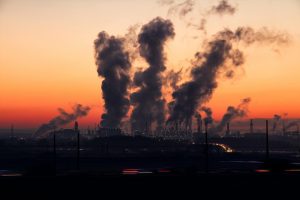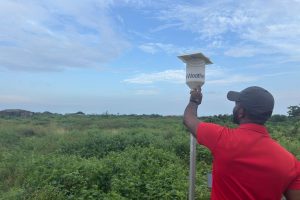
Rescue team captured in Hongkong during the flooding (July, 2025)
What do Paris, Texas, Mokwa, Hong Kong, Kinshasa, and Lagos have in common? Floods.
In 2025, cities across the globe found themselves submerged. From bustling metropolises to vulnerable inland towns, the devastation has been widespread—lives lost, homes destroyed, families displaced, and local economies dampened. These floods are not isolated events; they are signals of a changing climate demanding urgent attention.
With several weather-related disasters making it to the headlines, one thing is evident: we have seen how important the weather and climate are to us and how much impact they can have on our lifestyles, economies, and our future. The floods of 2025 have only amplified the voice of nature, and this time, it’s loud enough to shake the foundations of how we live. According to NASA’s Disasters Program, floods are the most commonly reported natural disaster globally, causing more loss of life and property than any other kind of extreme event1.

A rider stuggling to navigate a flooded street after heavy rainfall.
2025: The Year of the Flood
“2025 has been the year of the flood,” said WPLG-TV meteorologist Michael Lowry in an email to USA TODAY. Across the globe, this year has delivered some of the deadliest floods in living memory, and in many places, it has marked the worst flood season in decades. In early May, 2025, Milan and northern Italy were battered by one of their heaviest rainfalls in 170 years, causing the overflowing of the Lambro and Seveso rivers. This incident disrupted the activities in the cities, hereby causing authorities to declare a red alert2. The city parks were closed, mobile barriers were deployed, and emergency responders carried out thousands of rescue operations in under two days.
Hong Kong also faced some of its most extreme flooding on record in September 2023. The city was hit by its heaviest hourly rainfall since 1884 (158 mm in just an hour). This triggered their first-ever “black storm warning.” Less than two years later, in 2025, Hong Kong was once again hit by another heavy rainfall event in which the authority raised the alert to signal 10 (the highest point) for about seven hours before downgrading to signal 3 in the evening. The resultant flight disruptions were immense: 400 flights were cancelled or rescheduled, affecting approximately 80,000 travellers, as the airport authority scrambled to mitigate the chaos.
Here in Nigeria, we’ve watched entire communities vanish beneath rising waters. Mokwa, a town in Niger State, was nearly erased after relentless flash floods tore through homes, schools, and farmlands in late May. More than 500 people lost their lives, over 600 remain missing, and thousands have been displaced in just one week. Families were forced to flee in the night. Roads disappeared. Entire livelihoods were washed away. The same report can be given in other parts of the country, like Lagos. And heartbreakingly, this was just the beginning.
Flooding In Nigeria
Flooding in Nigeria is not new. But it’s becoming deadlier, more widespread, and harder to predict. Last year, over 5.26 million people were affected, and approximately 1.44 million hectares of farmland were lost.

Flood in Mokwa, Nigeria (2025).
The Forecast we Cannot Ignore
On April 11, 2025, the Nigeria Hydrological Services Agency (NIHSA) released its annual Flood Outlook, themed “Flood Resilience: Focusing on Communities’ Preparedness and Adaptation Strategies for Flood Management.” The forecast, presented in Abuja, warns that 30 states (out of the 36 states) and the Federal Capital Territory are at risk of flooding this year3. More than 1,200 communities have been identified as high-risk zones—some of them already facing early flood impacts. This wasn’t just a warning; it was a call to action. A recognition that business as usual, ignoring early signs and postponing infrastructure projects, no longer works.
According to the 2025 Flood Outlook and global experts, here are six urgent priorities for Nigeria:
- Build smarter infrastructure: stronger embankments, improved drainage systems, and flood-resistant road designs.
- Enable local adaptation: give communities the tools to plan their own defenses because they know their terrain best.
- Invest in real-time data: without current weather and water data, early warnings are impossible.
- Create a national adaptation plan: over 60 developing countries already have one. Nigeria remains unfinished.
- Close the insurance gap: more than 90% of flood victims in Nigeria have no protection.
- Leverage technology: forecasting tools, satellite imagery, and hyperlocal weather stations must become the norm—not the exception.
How can we prepare?
In this era of increasingly unpredictable weather, early access to reliable data can mean the difference between safety and disaster.
Our weather monitoring stations are built to detect and report the earliest signs of flood risk—giving communities the tools they need to act before it’s too late.
Each station collects and transmits hyperlocal data on:
- Rainfall intensity and accumulation
- Soil moisture saturation, which signals how close the ground is to flooding
- River or stream level changes
- Barometric pressure and atmospheric shifts tied to storms
These stations are solar-powered, built for remote deployment, and designed to thrive in both urban and rural conditions. The data they generate is delivered via mobile dashboard, API, or even SMS alerts, making it accessible to local governments, schools, farmers, and emergency agencies.
As we continue to roll out these systems across Nigeria, our goal is clear: to close the data gap that leaves communities unprepared. To provide real-time environmental intelligence and to transform uncertainty into foresight.




